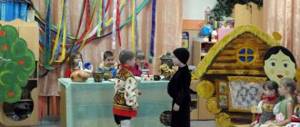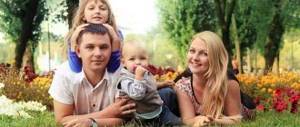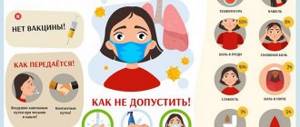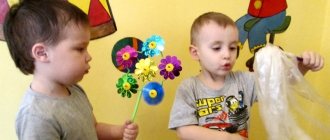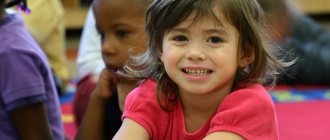Kindergarten No. 74
Both the boy and the girl contain two hundred grams of explosives, or even half a kilo. He must jump and jump, grab everything, kick his legs, otherwise he will explode from no one knows why.
I will not be mistaken if I say that parents at home often give preference to organizing quiet activities (drawing, reading books, watching TV, computer games).
Paying great attention to the aesthetics of their apartment, many adults do not find a place at home for a child with his irrepressible energy. Not everyone can host a sports complex at home. But you can do fun physical exercise without having equipment at hand. Meet the exercises that you can do together with your mom, dad, brother, sister, and even grandparents.
STRETCHED
Starting position: standing facing each other at a very close distance, holding hands and legs together. Rise on your toes, arms up through your sides - “pull” the child a little. Do not lift your feet off the floor.
LOOK OUT THE WINDOW
Starting position: standing with your back to each other at a distance of a step, hands on your belt, legs wider than shoulders. Lean down - see your partner's face. Do not bend your knees.
STILTS
Starting position: put the child on your feet, turning him with his back to you, hold him by the hands. Walk around the room without letting the child off your feet. Change the starting position - turn the child to face you, walk in different directions and in different ways: side step... experiment!
SWING
Starting position: standing facing each other at a distance of a step, feet together, holding hands. Alternate squats. We do it together (we wait until the partner gets up) and have fun!
CAROUSEL
Starting position: turn the child back to you. Raise the child by hugging him and circling him left and right. Do not overdo it! You may feel dizzy. After the exercise, secure your child.
PULL - PUSH
Starting position: sitting on the floor with your back to each other. The child bends forward and the adult bends backward, lying on his back. They chatted together. It is advisable not to bend your knees.
BOAT
Starting position: sitting on the floor facing each other, straight legs wider than shoulders, hands clasped. Bend forward and backward (rowing with oars). Do not bend your knees, perform the exercise smoothly without jerking.
HOUSE
Starting position: lying on your back, heads touching, holding hands. Raise your legs straight up, touch your partner’s toes with your toes.
BREVNYSHKO
Starting position: lying on your stomach facing each other, holding hands. Without opening your arms, roll left and right. Do the exercise at the same time.
WHEELBARROW
Starting position: the child lies on his stomach with emphasis on his palms. An adult takes the child by the ankles, the child rises in his arms and walks forward, the adult holds him. After finishing the exercise, carefully lower the child to the floor.
WE DO Push-ups
Starting position: the adult stands on all fours, and the child places his knees on the adult’s back and rests his straight arms on the floor. And he does push-ups cheerfully.
LET'S RIDE - the whole family can do the exercise
Starting position: all family members (the more, the better) are laid on their stomachs close to each other, the child is laid on top. All family members begin to simultaneously perform the log exercise, and the child rolls forward.
We perform each exercise 6–8 times.
Try to come up with as many new exercises as possible together with your child: you can add an object (ball, ball, etc.), a plot.
HEALTH AND GOOD LUCK IN YOUR CREATIVITY!
Bibliography
- Sirotyuk Exercises for psychomotor development of preschool children. – ARKTI, 2008. – 60 p.
- Furutan, Ali Akbar Fathers, mothers, children. Practical advice for parents. – M.: Progress, 1992. – 192 p.
- Khukhlaeva, O.V. Is there sunshine in every child? Parents about child psychology. Parents' library. – M.: Genesis, 2009. – 317 p.
- Fopel, K. Hello, legs! Outdoor games for children 3-6 years old, Educational games. – M.: Genesis, 2009. – 135 p.
- Volchkova I.M., Sandalova S.V. Morning exercises. From 3 to 5 years
- Ya. Berdykhova. Mom, dad, study with me. M: Physical culture and sport, 1990;
- E.N. Vavilova. Promoting children's health. Moscow, Education, 1986;
- IN AND. Telenchi. Hygienic principles of raising children. Moscow, Enlightenment. 1987;
- F.V. Tonkova-Yampolskaya, T.Ya. Chertok. For the sake of children's health. M; Education, 1985;
- I.I. Grebeshkova. M: Medicine 1990 Your child.
- A.G. Khripovskaya. The world of childhood. Moscow, Pedagogy, 1988.
- Kovalev L.N. “Sport in family education of children” - 1999. – 328 p.
- Nechaeva A.B. “Family and Sports” - 1998 – 376s.
- Reimers N.F. “Sports in a modern family” - Bustard, 2004. – 532 p.
Consultation for parents “Physical education at home”
RUSSIAN FEDERATION ROSTOV REGION
Administration of the city of Shakhty
municipal budget preschool educational
establishment of the city of Shakhty, Rostov region, “Kindergarten No. 62”.
346506 Russia Rostov region, Ostrovskogo st., 14 tel. (8636)23-13-66
MBDOU No. 62 in Shakhty
Consultations for parents
How to properly organize physical education classes for preschoolers at home.
For the proper development of the musculoskeletal system, our children need to perform a set of physical exercises at least once a day. Having regular, adapted exercise will allow your child to grow up healthy and strong. It is useful for parents to engage in physical education with their children and to instill in their children a love of physical education and sports by their own example. If parents and children engage in physical activity, the child will consider this to be the norm, like washing and brushing teeth in the morning.
To organize physical education classes with children, you must remember the following:
- It is advisable to carry out physical education classes at the same time. The only exception to the rule is if the child is ill.
— Physical education should be done before meals, on an empty stomach.
-It is best to conduct physical exercises outside (especially if you are in the country).
-Before physical education at home, it is advisable to ventilate the room well. This will allow you to combine physical exercise with hardening.
-During physical education classes, it is very important to monitor the accuracy and correctness of children’s movements, because the correct execution of exercises is the key to the correct and harmonious development of joints.
-Watch how your child breathes while doing physical exercises - you should try not to hold your breath, breathe through your nose, deeply, matching the rhythm of your breathing with your movements.
-If headaches or other unpleasant sensations appear during or after exercise, it is recommended to consult a doctor.
-In order to make the exercises more interesting, it is better to do physical education while listening to music.
By the age of 4, children can already freely perform the simplest movements, confidently walk, run, speak, think, and orient themselves in space. During this period, children surprise their parents by trying to help them with their work and imitate almost everything. However, we must not forget that during this period preschoolers still have limited, poorly developed motor capabilities. Basically, they are dominated by movements in which mainly large muscle groups are involved. A heavy load for them is the same type of movements, which cause increased fatigue in the child’s body, as well as long-term preservation of one stable, fixed position. Taking this into account, do not forget to alternate exercises with rest when conducting classes, especially those involving strength elements.
Physical developmental activities for preschoolers are recommended to be carried out in the form of imitative movements and games. The selection and dosage of exercises should depend on the age characteristics of the children.
When conducting classes (especially at the initial stage), do not forget about the individual characteristics of your child.
The variety of motor abilities of children requires an individual approach to them on the part of parents, which is especially important when engaging in physical exercise.
As you know, children at this age spend most of their time playing. Therefore, physical education and sports development activities for preschoolers should be structured in the form of a game. Exercises can consist of a variety of imitative movements. It is desirable that each exercise has its own fairy-tale or humorous name and is easy to remember. For example, “Cheburashka”, “Locomotive”, “Bunny”, etc. Such exercises are interesting for children and not tiring.
When compiling a set of exercises for your child, you need to select exercises so that they develop various physical qualities - strength, speed, agility, endurance, coordination of movements, flexibility. Exercises should also cover the child's different muscle groups. It is unacceptable that during classes, exercises are performed, for example, only for the muscles of the lower or upper extremities.
An important condition for the effectiveness of physical education classes with children is gradualism. You need to start with a small number of exercises and repetitions, and from session to session add 1-2 exercises or repetitions of movements. The sequence of performing exercises is also necessary - from simple to more complex. After all, the nervous regulation of a child’s heart is imperfect, and therefore the rhythm of his heart contractions quickly becomes confused, and the heart muscle, with inadequate physical influence, gets tired quite quickly. Moreover, for a preschooler, almost any elementary exercise, repeated many times with changes in the pace of execution, in itself promotes physical development.
Before starting to perform a new unfamiliar exercise with a child, it is advisable to explain its content to him, then show him and only then let him try it. Try not to make the explanation long, since perseverance and attention in children, especially at 3-4 years of age, can be unstable, and they are actually unable to concentrate on a long explanation.
Thus, when compiling a set of physical exercises for physical education at home with children, the following rules must be observed:
- The duration of classes with children 3-4 years old should be 15-20 minutes, respectively with children 5-7 years old - 20-30 minutes.
- It is recommended to include from 6 to 15 exercises in one lesson.
- Each exercise must be performed from 2 to 6 times (repetitions) depending on the age characteristics and motor readiness of the child.
- Remember to alternate exercise with rest.
- Exercises should be taught to the child in the form of imitative movements and games.
- Give each exercise a funny name.
- The complex should consist of exercises for various muscle groups that develop various physical qualities.
- Follow the rule of gradualism and consistency.
- Consider the individual characteristics of the child.
Knowing these nine rules, each parent will be able to choose the right exercises for their children and correctly compose a complex.
It is useful to learn simple exercises for a child at home. Each of these exercises should be done 3-6 times. Afterwards, run around the room or on the spot, raising your knees high and swinging your arms, then walk around and regain your breathing.
I offer an approximate set of exercises to develop strength for physical education classes with preschool children at home:
1. "Pendulum"
I.P.: stand - legs apart, fix your hands on your head. For each count, tilt your head 1 - to the right, 2 - to the left, 3 - forward, 4 - backward.
2. "Wave"
I.P.: stand - legs apart, arms out to the sides. Alternately perform wave-like movements with your arms, straining your arms in the final phase.
3. "Spinner"
I.P.: stand - legs together, arms parallel to the body down. On each count, rotate your torso to the right and then to the left, while freely moving your arms in the direction of each turn.
4. "Mill"
I.P.: stand - legs apart wider with the body tilted forward, hold your arms to the sides. For each count, rotate the body either to the right or to the left.
5. "Crocodile"
I.P.: lying position. Move forward on one hand. Avoid arching your lower back and do not use your legs to help.
6. "Scissors"
IP: lying horizontally on your back, resting on your forearms, legs slightly raised above the floor. Alternately make cross movements with straightened legs.
7. "Swing"
IP: lying on your stomach, keep your arms along your torso, legs slightly apart. Grab your shins with your hands, bend over and sway.
8. "Frog"
I.P.: crouched position, legs apart. Place your hands between your legs. Try to lift your feet off the floor while holding yourself on your hands. Hold the pose or jump.
9. "Bunny"
I.P.: crouching, hands on the back of the head. Jumping in a crouched position, with progressive movement forward. Keep your back straight.
10. "Kangaroo"
I.P.: stand - feet together, with hands below. Push off at a pace, bend your legs at the highest point and press them to your chest. After landing, repeat the jump again.
Be healthy!
Funds for school children
Physical education of school-age children continues on the basis of the principles laid down in preschool age. From 4 to 7 years old, it is recommended to invite the child to attend a sports section in the area that is most attractive to him. At home, exercise and active rest remain priorities. To continue the active physical development of a school-age child, it is advisable to use our tips:
- Encourage and motivate your child to attend the sports section : actively ask him about his successes, attend events related to sports, rejoice at the achievements of your son or daughter;
- Try to organize sports activities together: cycling, hiking and walking together, skiing and skating, attending various sports events;
- Remind and monitor your child’s compliance with the basic principles of maintaining health : daily routine, proper nutrition, physiologically correct body position during exercise;
- Provide the opportunity to walk outside for at least 1.5 hours every day;
- Expand your son or daughter’s knowledge about techniques for improving health and the importance of a healthy lifestyle.
- Introduce them to different sports , offer to try their hand at various types of outdoor activities.
- Be an example for your child.
The physical development of a child is painstaking work that requires patience and consistency from adults. Any load should be introduced gradually, taking into account the psychological and physical characteristics of your child. By adhering to the main goal of children's physical development, using simple principles, you can help your son or daughter improve immunity, form a beautiful body, cultivate important qualities and develop knowledge about the world around them.
If you liked the article, please share a link to it
Principles
To prevent the physical development of a child from becoming a difficult and incomprehensible task for adults and children, it is necessary to be guided by important principles of teaching children of preschool and school age:
- Activity and consciousness;
- Visibility;
- Personalization and accessibility;
- Systematicity;
- Dynamism.
Activity and consciousness
Any activity with a child should not only attract the child’s attention with its colorfulness, but also lead him to a conscious understanding of the capabilities of his body and an assessment of his feelings. Your son or daughter should not only repeat the exercise after you, but also enjoy it, develop a strong desire to perform various physical exercises every day, and lead an active lifestyle.
Visibility
Any exercises or games that you offer to your child must not only be explained in words, but also shown by example. Through visual images, the baby will better understand how to correctly perform the proposed element.
Personalization and accessibility
The proposed physical activity should always correspond to the level of development of the child’s physical data and be guided by his capabilities. It is unacceptable to ask a child to perform an exercise that he obviously cannot do , even if the age standards indicate it as necessary. In such a situation, it is necessary to slowly, gradually bring your son or daughter to a higher physical level at which performance will become accessible.
Systematicity
For the full physical development of children of preschool and school age, it is necessary to approach the learning process as a system, and not a one-time lesson. Ideally, you can carry out various training sessions with your baby every day, gradually complicating the tasks, increasing the level of physical development of your son or daughter.
Dynamism
A prerequisite for organizing the process of a child’s physical development is compliance with psychophysical time standards. Children, unlike adults, cannot work on one type of exercise for a long time. To maintain interest, it is necessary to build activities taking into account the baby’s ability to maintain attention. For preschool children, 3-5 repetitions of one element are enough, after which it is necessary to move on to another exercise. For younger schoolchildren, the number of repetitions can be increased to 7. Teenagers can perform one type of exercise for 10 - 15 minutes.
